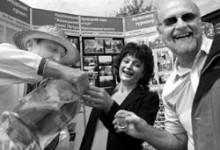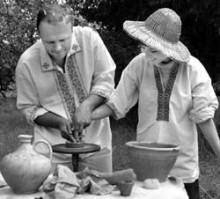The phrase “rural tourism” (“green tourism”) usually stumps people. What can you do in a village? What is there to see, say Ukrainians who are not familiar with this kind of tourism. Village vacations haven’t become fashionable in our country. People try to spend their holidays in Turkey or at least in the Crimea. People who are better off don’t want to relax at grandma’s house in Kirovohrad oblast.
But little by little this kind of tourism is expanding in Ukraine. Increasing numbers of people are ready and willing to take a vacation in a Ukrainian village. At the Fourth All-Ukrainian Trade Exhibition “The Ukrainian Village Invites,” held at the Ukrainian Museum of Architecture and Daily Life in the village of Pyrohove near Kyiv, organizers and participants gladly told visitors about this exciting form of tourism. The exhibition was organized by the Union to Support Rural Green Tourism in Ukraine. Thousands of national craftsmen, artists, and green tourism specialists, who have been popularizing this sort of vacation for years, took part in the exhibition.
Rural “tour operators” do everything they can to attract tourists. The exhibition was divided into 25 displays, each representing a Ukrainian region, including the Crimea. Residents brought everything they thought might be of interest to visitors. Two stuffed ostriches, for example, were brought to the capital from Mykolayiv oblast. For those who don’t know, there is an ostrich farm there. To bring home the fact that the ostriches were Ukrainian, their heads were decorated with little wreaths and multicolored ribbons.
Next to the stuffed ostriches rested a huge leg of mutton and a piglet in aspic. At first glance it would seem that the residents of Mykolayiv simply grabbed these foods with them. But in fact all these things have a direct connection to tourism-rural tourism, of course. If you decide to take a vacation in Bashtanka raion in Mykolayiv oblast, rest assured that you will visit the ostrich farm. They also know how to prepare roast piglets.
The same goes for every other region. The stand representing Luhansk oblast featured a whole row of alcoholic drinks. (I immediately thought of a recently published guide to Kyiv, which advises visitors not to drink with Ukrainians). There were different kinds of puppets, all very beautiful, with sparkling eyes and half- smiles. This is a hint to visit the Luhansk Puppet Theater. All those embroidered shirts, towels, and crafts fashioned from wood, glass, beads, and other materials are a testament to the rich crafts of this region, which offer interesting activities for tourists. If you choose the right village, you will be taught not only how to embroider but to throw clay pots and even fire them in the kiln. In a word, the question of what tourists can do in villages instantly disappears.
You could learn how to throw clay pots at the exhibition — I was practically forced to make a candlestick. “May I borrow the young lady from you for five minutes?” the potter asked our press photographer. He didn’t mind, and in a few minutes I was dressed in an embroidered blouse and straw hat, and up to my elbows in clay. The potter, whose name was Ivan, din’t let on exactly what we were throwing until the very last second, while guiding my hands on the potter’s wheel.
At first I asked if we were making a little plate. “As if we would dirty our hands for a little plate!” said the indignant Ivan. “A little pot, maybe?” I continued. But no, we weren’t going to all that trouble over a little pot. In the end I was surprised to see a candlestick. It was a little bit crooked but attractive nonetheless. Ivan gave it to me as a souvenir of my first pottery experience.
Visitors could see lots of wonderful things at the exhibition. There was a skull of a large- toothed and tusked animal nailed to a board. The owner assured us it was the middle head of Zmiy Horynych (firedrake). A few steps away was a steel Zmiy Horynych from Ivano-Frankivsk oblast. Its creator, master of artistic blacksmithing Viktor Semenyuk, says he could do a lot to help developm village tourism: “I suggested making a centaur and wanted to make the Zmiy Horynych bigger-six meters high.”
But there’s no support from the government. It would be so fine to see a six-meter-high Zmiy Horynych in the middle of some regional center, or even better, in an ordinary village.
The display stand organized by the residents of Ivano-Frankivsk oblast was very interesting. Their natural wool bedspreads, called “lizhnyky,” are superb. If these artisans had brought their “lizhnyky” to Kyiv during our last cold winter, they would have returned empty-handed. Folk arts master Vasyl Kopchuk has been demonstrating the technique of turning wool into blankets for years.
“You can go to the river or head for the forest to gather berries and mushrooms,” I was told by rural residents, who regularly receive guests from all over Ukraine and abroad. “You can sing.” Then it’s the visitors’ choice. Some rural tour operators lure guests to their saunas or absolutely enchanting landscapes. But judging from the display stands, every visitor to a Ukrainian village should partake of the local foods. Nearly every stand offered food samples, hot or cold, but always served with the traditional “hundred grams” and a Bon appetit.
Especially striking was the Kyiv region’s spread. There were thick slices of rye bread and equally huge pieces of salo “reclining” (I can’t describe it differently) on the table. Next to this were home-made sausages and peeled onions. As they say, this simple but tasty food will impress foreigner guests.
Actually, a village vacation is not that expensive. The Rural Tourism Center, “The Beauty of the Carpathians,” offers vacation packages for only 20 hryvnias a day per person. They don’t provide any details on the type of accommodations, but visitors can go to the mountains, visit caves, swim in mountain rivers, go horseback riding, fish, or go on excursions to the ancient castles and monasteries of Zakarpattya, thermal pools, salt lakes, or mineral springs.
Of course, the cost of accommodation depends on its class. If you want a room with a spa-sauna, you pay 300 hryvnias for a two-day stay. If you don’t want a spa and don’t mind using an outhouse in the yard, you can spend a weekend and only pay 30 hryvnias. But regardless of the surrounding nature and calming atmosphere, those notorious bathroom facilities and other rural “conveniences” frighten tourists. Our roads go a long way to scaring off visitors. Reaching a remote place is sometimes so difficult that not every tourist is courageous enough to start on his journey. This is the main problem besetting rural tourism.











